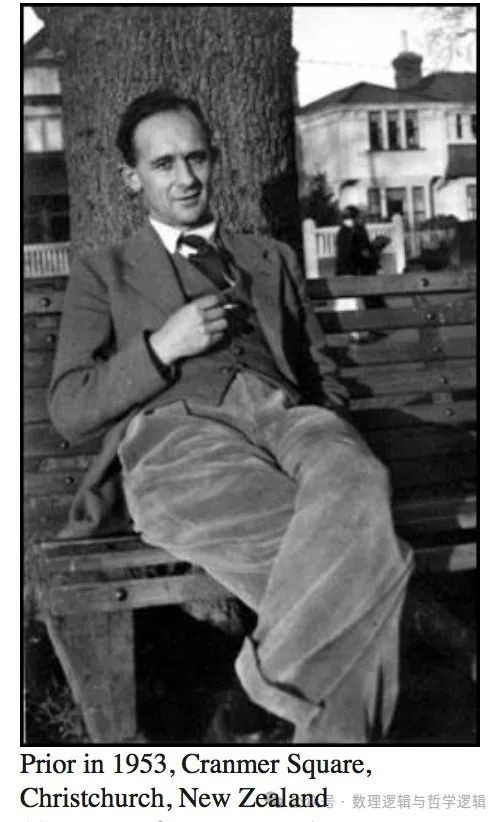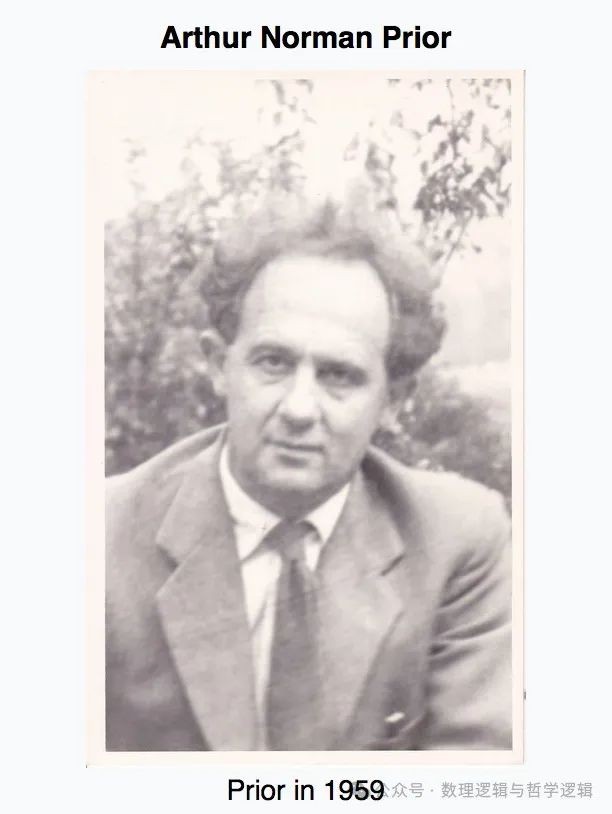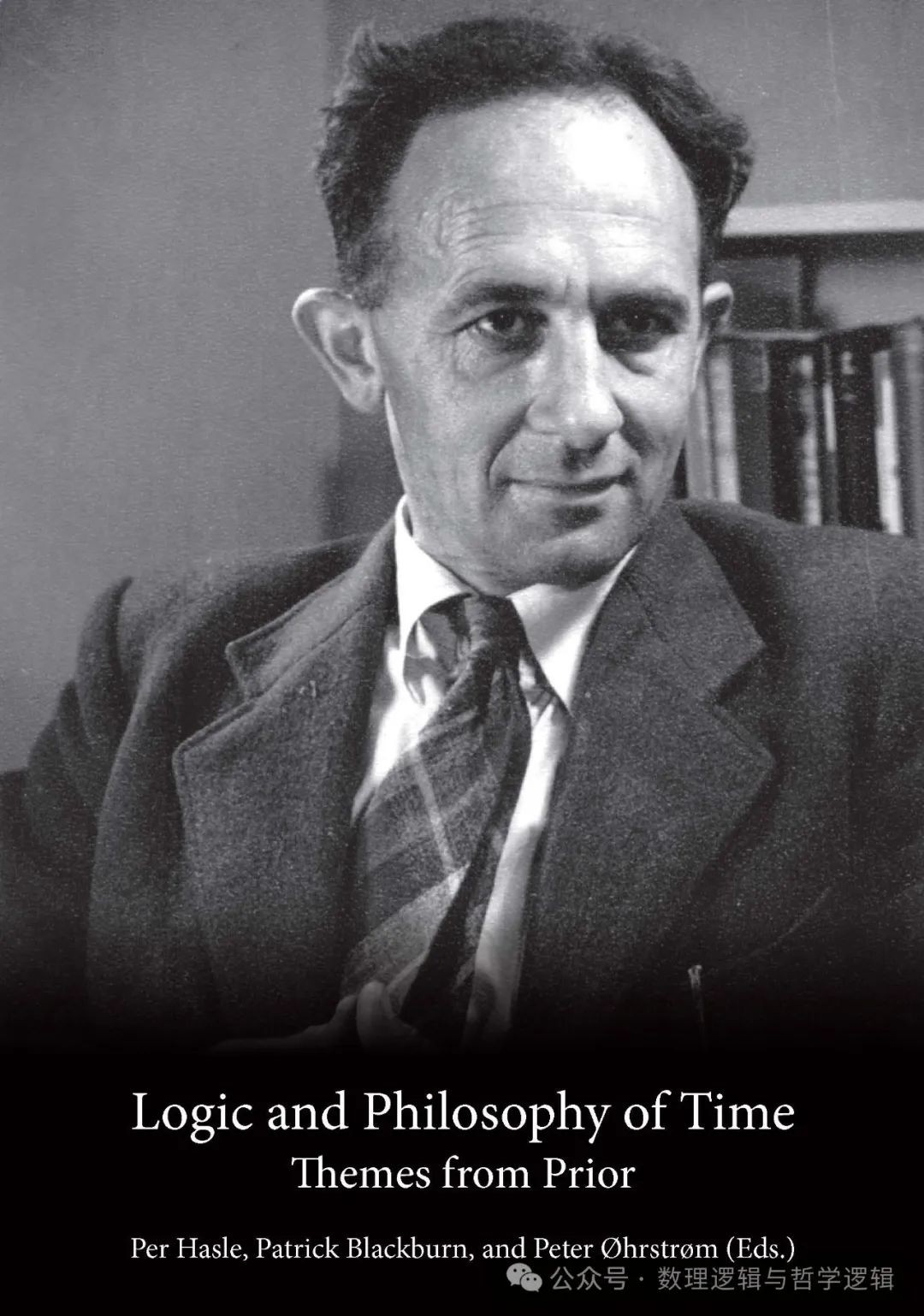博文
现代时态逻辑的创始者 - 普莱尔
 精选
精选
||
[敬请读者注意] 本人保留本文的全部著作权利。如果哪位读者使用本文所描述内容,请务必如实引用并明白注明本文出处。如果本人发现任何人擅自使用本文任何部分内容而不明白注明出处,恕本人在网上广泛公布侵权者姓名。敬请各位读者注意,谢谢!
现代时态逻辑的创始者 - 普莱尔
程京德
普莱尔(Arthur Norman Prior, 4 December 1914 – 6 October 1969)是出生于新西兰(父母是澳大利亚人)的逻辑学家哲学家,现代时态逻辑(Tense/Temporal Logic)的创始者[1-3]。普莱尔也被认为是现代混合逻辑(Hybrid Logic)的创始者(详见本文最后部分)。
普莱尔受邀担任1955-1956年度的牛津大学“洛克讲座(The John Locke Lectures)”[4]讲师,讲座题为“Time and Modality”[4-10],并将其讲座内容整理成为学术著作于1957年出版[1],这部著作被世界逻辑学界公认为现代时态逻辑学的创始之作[5-13]。牛津大学“洛克讲座(The John Locke Lectures)”(一般一个学期内的数周)是世界上最著名的哲学讲座系列,始于1950年。世界上大多数最伟大的哲学家都是该讲座系列的受邀者(原本首位受邀者是维特根斯坦,但是被其辞退了,理由是不想做没有时间问答讨论的形式上的讲座),普莱尔是第三位受邀者,他前面的受邀者是著名美籍华裔数理逻辑学家王浩(第二次)和美国分析哲学家鲍斯马(首次)[4]。
普莱尔于1935年毕业于新西兰奥塔哥大学(University of Otago),获得哲学及心理学学士学位,并于1937年获得哲学及心理学硕士学位[5-10]。普莱尔的学术生涯始于1946年,在新西兰坎特伯雷大学学院(University of Canterbury College)哲学系,普莱尔在1946年获得他的第一个职位讲师,填补卡尔·波普尔离开那里之后的空缺,在1949年被任命为高级讲师,在1952年被任命为哲学教授,并在1953-1958年担任系主任[5-10]。普莱尔曾经于1955-1956年在牛津大学担任过客座讲师一年,他于1958年底离开新西兰移居英国,1959年开始在曼彻斯特大学担任哲学教授,直到1966年被选为牛津大学贝利奥尔学院(Balliol College)的Fellow并被任命为哲学Reader[5-10]。1963年,普莱尔被选为英国国家学术院院士(Fellow of the British Academy, FBA)[5,8]。普莱尔分别在1962年和1965年担任过芝加哥大学和加利福尼亚大学的客座教授,通常被认为是普赖尔最重要的著作“Past, Present and Future”[2]就是在加利福尼亚大学访问期间撰写的[5-10]。1969年9月,普莱尔前往奥斯陆;他原计划于1969年秋季在奥斯陆大学开设一门课程,并在挪威的大学里演讲。10月6日,就在普莱尔准备在挪威特隆赫姆大学演讲的前一天晚上,他因心脏病发作去世,享年仅不到55岁。

“时间”(及“空间”)在宇宙中起着非常重要的作用,无疑是我们人类认知世界当中最重要的基础概念之一(“空间”也是)。“时间”究竟是什么?是客观存在还是人类心智主观意识?时间是基于瞬间还是基于间隔?时间是离散的、密集的、还是连续的?时间是否有开始或者结束?时间是线性的、分枝的还是循环的?关于时间的本质及其性质的讨论,从古希腊时代(赫拉克利特、巴门尼德、芝诺、柏拉图、亚里士多德)开始在哲学和科学中就一直占据着显著地位,至今也还并未完全统一为各门学问学科公认的理论[14]。通常,从科学(物理学)的角度出发,一般把“时间”视为描述事件发生变化的顺序、持续、间隔的基本维度,从过去、现在、到未来,以一种不可逆的顺序发生。“时间”是众多科学与技术的概念基础之一(“空间”也是)。于是,无论从哲学、语言学、科学、技术的哪个领域来说,与“时间”概念相关的论证及推理都是必不可少的,其有效性正确性标准当然是逻辑学需要研究清楚的课题。
时态逻辑(Tense/Temporal Logic)是关于时间的形式逻辑学,它研究时态命题的表达及其随时间变化的真值语义、由时态命题构成的论证及推理的有效性正确性及其评价标准等,是哲学逻辑的一个重要分支。时态逻辑作为一种形式逻辑系统直到20世纪50年代初才出现,是由普莱尔的工作[1-3]所创立的。
普莱尔复活了中世纪哲学家们试图为自然语言制定一个时间逻辑的尝试。普莱尔认为中世纪逻辑在时间和时态方面的核心原则/假设可以总结为两点:一,时态区分是逻辑反思的合适主题,二,在某个时间点是正确的事情,在很多情况下在另一个时间点是错误的,反之亦然[1]。普莱尔观察到,古代和中世纪初的逻辑学家们认为这些原则/假设是理所当然的,但在文艺复兴之后,它们最终被否定或忽略。事实上,时态逻辑的衰落始于对时间结构的兴趣逐渐丧失,也就是说,第一项首先被不同的逻辑学派抛弃,而第二项后来才被拒绝。而普赖尔哲学的核心思想是:时态命题可能在某一时刻为真,而在另一时刻为假。普赖尔曾经写道:“当然,存在着不变的真理,但也有变化的真理,如果逻辑忽视了这些真理,而让相对非形式的“辩证法家”去研究现实中更“动态”的方面,那就太可惜了。(Certainly there are unchanging truths, but there are changing truths also, and it is a pity if logic ignores these, and leaves it … to comparatively informal ‘dialecticians’ to study the more ‘dynamic’ aspects of reality.)”[7]
“普赖尔最伟大的成就无疑是他对现代时态逻辑的发展。从20世纪50年代中期开始,他几乎凭一己之力为现代逻辑这一重要学科奠定了基础。在他去世后的最初几十年里,人们几乎只记得普赖尔的这一无可否认的伟大成就。(The greatest achievement of A. N. Prior (1914–1969) was without doubt his development of modern temporal logic. From the mid-1950s and onwards, he almost singlehandedly laid out the foundation for this important discipline of modern logic. In the first decades after his death, Prior was remembered almost exclusively for this undeniably great achievement.)”[9] “普赖尔1968年出版的“Papers on Time and Tense”中该主题的参考书目显示,直到1965年,该领域唯一的出版物要么是普赖尔本人撰写的,要么是对其著作(主要是“Time and Modality”)的评论。(The bibliography of the subject in Prior’s 1968 volume Papers on Time and Tense reveals that up until 1965 the only publications in the field were either by Prior himself or were reviews of his work (chiefly of Time and Modality))”[7]
普赖尔在其时态逻辑基本语言中引入了四个时态运算符 P, F, H, G,扩展了标准的经典命题逻辑语言,其语义解释如下[1-3,13]:
P: “It was (at some point in the Past) the case that …”
F: “It will (at some point in the Future) be the case that …”
H: “It Has always been the case that …”
G: “It is always Going to be the case that …”
P:“过去某个时间点是 …”
F:“未来某个时间点是 … ”
H:“一直以来都是 … ”(Hp = ~P~p, p为任意命题)
G:“永远都是 … ”(Gp = ~F~p, p为任意命题)
普赖尔还首次构建了线性时态逻辑和分枝时态逻辑的形式逻辑公理系统[1-3,13]。
基于普赖尔的开创性工作,几十年来,时态逻辑已经蓬勃发展成为哲学逻辑中内容最丰富,在哲学、语言学、计算机科学及人工智能等众多领域应用最广泛的一个分支[7-13,15-24]。
1989年,为了纪念普赖尔的国际会议在新西兰坎特伯雷大学举行,出版了论文集[25]。
2016年10月1日,在丹麦独立研究委员会(the Danish Council for Independent Research)的资助下,由六个丹麦大学(奥尔堡大学(主导)、罗斯基勒大学、哥本哈根大学、奥胡斯大学、南丹麦大学和丹麦技术大学)的研究组参加的为期三年的研究项目“The Primacy of Tense – Prior’s Now and Then”启动,主要研究:一、普赖尔的遗作研究及普赖尔研究的发展,二、普赖尔思想在当代思想中的意义,三、普赖尔著作对逻辑本身,尤其是现代混合逻辑的影响。这个研究项目的成果已经出版了五册论文集[26-30]。其中,文章[31]综述了互联网上关于普莱尔研究的资源。
除了时态逻辑,普莱尔也被认为是现代混合逻辑(Hybrid Logic)的创始者[32-34]。普莱尔创建现代时态逻辑时期,为了扩展模态逻辑的表达能力,从1951年开始首次独创性地提出了在模态逻辑语言中引入一类新的命题符号“名词(nominals)”并给与其语义解释(每个名词命题符号严格地在仅一个可能世界中被解释为真)的思想和相应的技术处理手段,是现代混合逻辑的开创性先驱工作[32-34]。
普莱尔在逻辑方面的工作范围远不止仅限于时态逻辑:他对模态逻辑、规范/道义逻辑、量化理论、真理论和逻辑学史都做出了重要贡献。在普莱尔的著作中,他还讨论了伦理、自由意志和神学问题[9]。
笔者将另文详细介绍时态逻辑学及其应用。
参考文献
[1] A. N. Prior, “Time and Modality (John Locke Lecture),” Oxford University Press, 1957.
[2] A. N. Prior, “Past, Present and Future,” Oxford University Press, 1967.
[3] A. N. Prior, “Papers on Time and Tense,” Oxford University Press, 1968; Second Expanded Edition by P. Hasle, P. Øhrstrøm, T. Braüner, and J. Copeland, Oxford University Press, 2003.
[4] Faculty of Philosophy, “The John Locke Lectures”, University of Oxford.
[5] A. Kenny, “Arthur Norman Prior (1914-1969),” Proceedings of the British Academy, Vol. 56, pp. 321-349, 1970.
[6] I. Thomas, “In Memoriam:A. N. Prior (1914-1969), Notre Dame Journal of Formal Logic, Vol. XII, No. 2, pp. 129-130, 1971.
[7] B. J. Copeland, “Arthur Prior,” The Stanford Encyclopedia of Philosophy, Center for the Study of Language and Information (CSLI), Stanford University, 1996-2020.
[8] P. Hasle, “The Life of Prior (1914-69) - A Brief Overview by Per Hasle,” Prior Studies - Life and Work of Arthur Norman Prior.
[9] P. Øhrstrøm and P. Hasle, “A. N. Prior's Logic,” in D. M. Gabbay and G. Woods (Eds.), “Handbook of the History of Logic,” Vol. 7, pp. 399-446, Elsevier, 2006.
[10] P. Øhrstrøm, P. F. V. Hasle, and D. Jakobsen, “A. N. Prior's Logic,” Internet Encyclopedia of Philosophy.
[11] P. Øhrstrøm and P. F. V. Hasle, “Temporal Logic - From Ancient Ideas to Artificial Intelligence,” Kluwer Academic, 1995.
[12] Y. Venema, “Temporal Logic,” in L. Goble (Ed.), “The Blackwell Guide to Philosophical Logic,” pp. 203-223, Blackwell, 2002.
[13] V. Goranko and A. Rumberg, “Temporal Logic,” The Stanford Encyclopedia of Philosophy, Center for the Study of Language and Information (CSLI), Stanford University, 1999-2024.
[14] A. Bardon, “A Brief History of the Philosophy of Time,” Oxford University Press, 2013.
[15] N. Rescher and A. Urquart, “Temporal Logic,” Springe, 1971.
[16] R. Goldblatt, “Logics of Time and Computation, 2nd Edition, Revised and Expanded,” CSLI Publications, 1992.
[17] D. M. Gabbay, I. Hodkinson, and M. A. Reynolds, “Temporal Logic: Mathematical Foundations and Computational Aspects: Volume 1,” Clarendon Press, 1994.
[18] D. M. Gabbay, M. A. Reynolds, and M. Finger, “Temporal Logic: Mathematical Foundations and Computational Aspects: Volume 2,” Oxford University Press, 2000.
[18] S. Demri, V. Goranko, and M. Lange, “Temporal Logics in Computer Science,” Cambridge University Press, 2016.
[20] S. Centrone and K. Mainzer, “Temporal Logic - From Philosophy and Proof Theory to Artificial Intelligence and Quantum Computing,” World Scientific, 2023.
[21] V. Goranko, “Temporal Logics,” Cambridge University Press, 2023.
[22] J. P. Burgess, “Basic Tense Logic,” in D. Gabbay and F. Guenthner (Eds.), “Handbook of Philosophical Logic, Second Edition,” Vol. 7, pp. 1-42, Kluwer Academic, 2002.
[23] M. Finger, D. Gabbay, and M. Reynolds, “Advanced Tense Logic,” in D. Gabbay and F. Guenthner (Eds.), “Handbook of Philosophical Logic, Second Edition,” Vol. 7, pp. 43-203, Kluwer Academic, 2002.
[24] P. Øhrstrøm and P. Hasle, “Modern Temporal Logic: The Philosophical Background,” in D. M. Gabbay and G. Woods (Eds.), “Handbook of the History of Logic,” Vol. 7, pp. 447-498, Elsevier, 2006.
[25] B. J. Copeland (ed.), “Logic and Reality - Essays on the Legacy of Arthur Prior,” Clarendon Press 1997.
[26] P. Hasle, P. Blackburn, and P. Øhrstrøm (Eds.), “Logic and Philosophy of Time - Themes from Prior, Volume 1,” Aalborg University Press, 2017.
[27] P. Blackburn, P. Hasle, and P. Øhrstrøm (Eds.), “Logic and Philosophy of Time - Further Themes from Prior, Volume 2,” Aalborg University Press, 2019.
[28] D. Jakobsen, P. Øhrstrøm, M. Prior, and A. Rini (Eds.), “Logic and Philosophy of Time - Three Little Essays. Arthur Prior in 1931, Volume 3,” Aalborg University Press, 2020.
[29] P. Hasle, D. Jakobsen, and P. Øhrstrøm (Eds.), “Logic and Philosophy of Time - The Metaphysics of Time, Volume 4,” Aalborg University Press, 2020.
[30] D. Jakobsen, P. Hasle, and P. Øhrstrøm (Eds.), “Logic and Philosophy of Time - The History and Philosophy of Tense-logic, Volume 5, No. 1,” Aalborg University Press, 2023.
[31] F. Sabir, P. R. Blackburn, and J. L. Kofod, “The Past, Present and Future of the Prior Internet Resources,” in D. Jakobsen, P. Hasle, and P. Øhrstrøm (Eds.), “Logic and Philosophy of Time - The History and Philosophy of Tense-logic, Volume 5, No. 1,” Aalborg University Press, 2023.
[32] P. Blackburn, “Arthur Prior and Hybrid Logic,” Synthese, Vol. 150, Issue 3, pp. 329-372, 2006.
[33] C. Areces and B. ten Cate, “Hybrid Logics,” Studies in Logic and Practical Reasoning, Vol. 3, pp. 821-868, 2007.
[34] T. Braüner, “Hybrid Logic,” The Stanford Encyclopedia of Philosophy, Center for the Study of Language and Information (CSLI), Stanford University, 2006-2021.
微信公众号“数理逻辑与哲学逻辑”
https://blog.sciencenet.cn/blog-2371919-1467533.html
上一篇:论“幻觉”的误用及大语言模型的正确使用(上)
下一篇:科学研究规划及实践(1) - 讲座介绍


